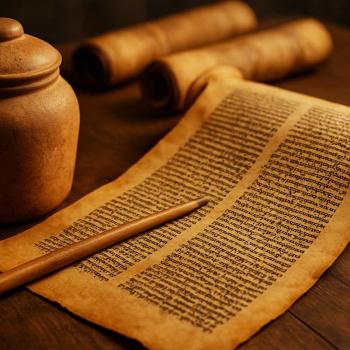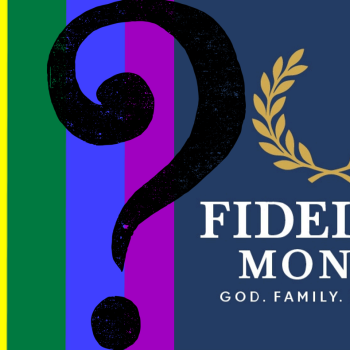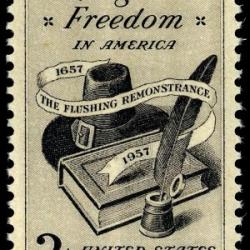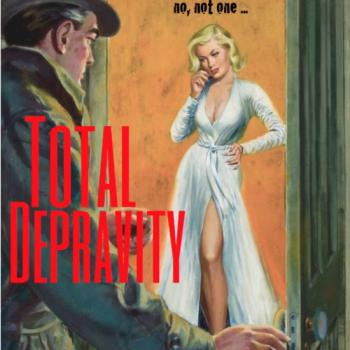• I was enjoying this discussion of religious liberty in America — “Religious liberty has a history – and why Americans feel strongly about it” — right up until the end. Two Vanderbilt historians named James do a nice job summarizing the development of freedom of conscience from Roger Williams to Muhammad Ali. The two Jims even include a quick discussion of the way the Bill of Rights was extended and nationalized by the Reconstruction Amendments (which is another reason the current SCOTUS is so determined to delegitimize and erase those cornerstones of the Constitution).
It’s good stuff … up until this wobbling landing in the final paragraph:
The free exercise and establishment clauses of the First Amendment live in perpetual tension – two goods that must be balanced. The Supreme Court’s recent religious liberty rulings are fully a part of America’s long struggle to define religious freedom and only the most recent attempt to achieve a balance between goods.
No. That gobbledygook about “tension” has become the standard boilerplate language people who know better stick into discussions of the First Amendment as a conciliatory “both sides” gesture. But it’s nonsense. The only “tension” between the two religion clauses comes from the fact that anyone who wants to weaken either will wind up destroying both sides.
Every official establishment of religion is a violation of free exercise. Free exercise requires no establishment. The two clauses are necessarily complementary.
The imagined “tension” between these two clauses comes from those who insist that they can only freely exercise their religion by establishing it over others. These folks think that making their own sectarian beliefs official, mandatory, or hegemonic will enhance their own religious liberty (even if that means a reduction in the religious liberty of others).
But that ain’t how it works. That’s not how it has ever worked.
Members of the established sect always come to realize that establishment constrains their own liberty just as surely as it constrains the liberty of the infidels, dissenters, religious minorities, and free thinkers. Establishment means privilege, and with privilege inevitably comes testing to ensure that the privileges are not distributed to the unworthy. Adherents of the official, established sect will thus be expected to prove their standing as legitimate, unwavering members of that sect. And they will be asked and required to perform this proof. Constantly.
Inquisitions, in other words. You can’t have religious establishment without them. And, yes, inquisitions are especially bad for dissenters and religious minorities (Jews, particularly, wherever the established religion is any form of Christianity). But they’re no picnic even for the most earnestly devout believers in the official and established privileged sect who must be vigilantly prepared for high-stakes catechizing at any moment.
Establishment and the accompanying need for some form of inquisition thus inevitably changes the official sect. The practice of it becomes centered more on the proof of proper belief than on whatever the content or substance of that belief had been. And the content and substance of it changes too, as those tests and proofs are refined to incorporate ever more adiaphora, thereby essentializing previously obscure or optional aspects of the faith.
It’s not just that established religion winds up hanging Mary Dyer on Boston Common, but that it also turns every good, loyal Puritan into someone whose faith is centered around not being the next in line for the gallows.
That, it seems to me, is a form of “tension” we could all do without.
• This (via Mark Evanier) is cool: An ASL production of the classic Broadway musical The Music Man.
James Caverly (who was terrific as “the boy from 6B” in Only Murders in the Building) stars as Harold Hill, leaning into the idea that Hill’s music-teacher scam is even more audacious when Hill and all those kids are deaf.
This production recalls the play that first got me involved with the odd little theater company here in Philly that’s as close as I’ve ever gotten to being a “real” actor. They were putting on Tom Minter’s Perfection Unspeakable, an ambitious, wonderfully strange play. It was the story of two angels arguing about whether or not humans have free will. The angels — two terrific deaf actors — never left the stage, carrying on their argument in ASL while observing or orchestrating the actions of us mortals (the hearing part of the cast). Our part of the story was a grim Noir — femme fatale, doomed antihero who falls for her, etc. (My tiny role was a cop — corrupt, indifferent, and in “forget it, Jake, it’s Calvinism” mode the whole time.)
I’m not sure if our production wholly came together, but it looked amazing. The angels truly seemed uncanny, gliding amongst us mortals invisibly as we carried on, oblivious to their presence. The way they sometimes continued their conversation even when not looking at one another could be chilling and otherworldly.
This all made blocking immensely important (no bumping into the angels). And it meant that we humans had to stick to the script — you can’t be improvising when the angel hovering behind you is signing the words that you speak.
For the non-signing audience, our production had two offstage actors speaking the angels unspoken lines into microphones. The Music Man production solves this problem with a supertitle screen above the stage, projecting the words above the action for those in the audience unable to follow the ASL. I like the way that accommodates the whole audience while also flipping the script on accessibility.
No larger point here other than to say I’m happy this is happening. It’s at the Olney Theater Center in Maryland through next Sunday.
















